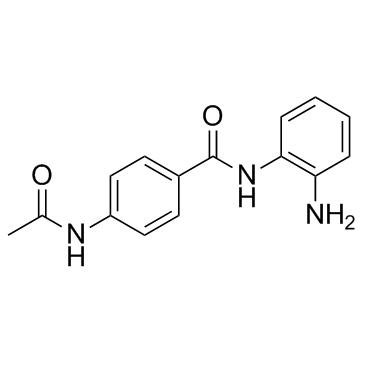
CI-994
CAS No. 112522-64-2
CI-994 ( Acetyldinaline;Tacedinaline;PD-123654;Goe-5549 )
产品货号. M10439 CAS No. 112522-64-2
A potent, selective class I HDAC inhibitor with IC50 of 0.9/0.9/1.2 uM for HDAC1/2/3, respectively.
纯度: >98% (HPLC)
 COA
COA
 Datasheet
Datasheet
 HNMR
HNMR
 HPLC
HPLC
 MSDS
MSDS
 Handing Instructions
Handing Instructions
| 规格 | 价格/人民币 | 库存 | 数量 |
| 10MG | ¥348 | 有现货 |


|
| 50MG | ¥535 | 有现货 |


|
| 100MG | ¥786 | 有现货 |


|
| 200MG | ¥1385 | 有现货 |


|
| 500MG | ¥2989 | 有现货 |


|
| 1G | 获取报价 | 有现货 |


|
生物学信息
-
产品名称CI-994
-
注意事项本公司产品仅用于科研实验,不得用于人体或动物的临床与诊断
-
产品简述A potent, selective class I HDAC inhibitor with IC50 of 0.9/0.9/1.2 uM for HDAC1/2/3, respectively.
-
产品描述A potent, selective class I HDAC inhibitor with IC50 of 0.9/0.9/1.2 uM for HDAC1/2/3, respectively; show no significant inhibitory activity against HDAC8 (IC50>20 uM); reduces S phase level and increases apoptosis in A-549 and LX-1 cells; demonstrates antitumor activity against several tumor models, including the chemo-resistant mouse pancreatic ductal carcinoma as well as the human prostate tumor model LNCaP.Breast Cancer Phase 2 Discontinued
-
同义词Acetyldinaline;Tacedinaline;PD-123654;Goe-5549
-
通路Cell Cycle/DNA Damage
-
靶点HDAC
-
受体HDAC1;HDAC2;HDAC3
-
研究领域Cancer
-
适应症Breast Cancer
化学信息
-
CAS Number112522-64-2
-
分子量269.30
-
分子式C15H15N3O2
-
纯度>98% (HPLC)
-
溶解度DMSO: ≥ 58 mg/mL
-
SMILESO=C(NC1=CC=CC=C1N)C2=CC=C(NC(C)=O)C=C2
-
化学全称Benzamide, 4-(acetylamino)-N-(2-aminophenyl)-
运输与储存
-
储存条件(-20℃)
-
运输条件With Ice Pack
-
稳定性≥ 2 years
参考文献
1. Moradei OM, et al. J Med Chem. 2007 Nov 15;50(23):5543-6.
2. el-Beltagi HM, et al. Cancer Res. 1993 Jul 1;53(13):3008-14.
3. Loprevite M, et al. Oncol Res. 2005;15(1):39-48.
2. el-Beltagi HM, et al. Cancer Res. 1993 Jul 1;53(13):3008-14.
3. Loprevite M, et al. Oncol Res. 2005;15(1):39-48.
产品手册



关联产品
-
Remodelin hydrobromi...
A potent inhibitor of the acetyl-transferase protein NAT10 that acetylates both histones and microtubules.
-
BRD-73954
The first HDAC6/8 dual inhibitor with IC50s of 36/120 nM.
-
Valproic acid sodium...
A HDAC inhibitor that selectively inhibits the catalytic activity of class I HDACs, and induces proteasomal degradation of HDAC2.



 021-51111890
021-51111890 购物车()
购物车()
 sales@molnova.cn
sales@molnova.cn







